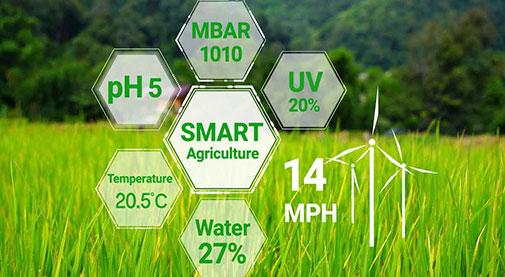Agriculture is a USD 5 trillion industry globally. Now, the industry is turning to digital technologies so that market player, including agri-tech start-ups, can take advantage of next-generation technology such as data digitization and data platforms, data analytics, artificial intelligence (AI), machine learning (ML), internet of things (IoT), and many others to help yield healthier crops, control pests, monitor soil, and growing conditions, and organize data for false reporting.
Technology adoption in agri-tech (agricultural) assists in resolving various pain points across the traditional agriculture value chain, with a market potential of USD 24 billion.
Let’s examine how agri-tech startups are changing the way agriculture is traditionally done at every stage of the value chain.
Using AI for intelligent spraying of chemicals – Brings in cost savings.
Thousands of data points on temperature, soil, water usage, weather, and other factors are generated daily on farms. The data is then used in real-time using artificial intelligence solutions and machine learning models to gain helpful insights such as when to sow seeds, which crops to choose, which hybrid seeds to use for higher yields, etc.
Precision agriculture is a term used to describe how AI solutions are helping to enhance overall harvest quality and accuracy. AI technology aids in the detection of plant disease, pests, and poor agricultural nutrition. AI sensors can detect and target weeds, then determine the best herbicide to use in the area. This reduces the use of herbicides and saves money. Many technical businesses have created weed-monitoring and spraying robots that use computer vision and artificial intelligence.
These robots can eliminate 80% of the chemicals that are currently sprayed on crops and reduce herbicide costs by 90%. As a result, these clever AI sprayers can reduce the number of pesticides used in the fields, increase the quality of agricultural products, and save money.
Farm harvesting with AI-based robots — Meeting the labor shortage

Have you ever wondered who harvests the crops from the farmland? In most situations, robotic devices capable of mass harvesting with greater accuracy and speed get the product to your kitchen table rather than traditional field workers. These artificial intelligence solutions aid in increasing productivity and reducing waste from crops left in the field.
Many businesses are attempting to increase agricultural efficiency. For instance, autonomous strawberry-picking equipment and vacuum equipment that can gather mature apples from trees are available. Sensor fusion, machine vision, and artificial intelligence models are used by these devices to locate harvestable produce and pick the right crops.
Agriculture is the second-largest industry behind Defense regarding the number of service robots deployed for professional use. According to the International Federation of Robotics, 25,000 agricultural robots have been sold, roughly matching the number employed for military purposes.
Predictive analytics with AI — Allows for better decision-making.
Trying to figure out when the optimum time is to seed
The difference between a successful harvest and a bad one is timely information on a single data point: seed sowing. To tackle this, ICRISAT scientists developed a predictive analytics technique to determine the best time to sow the seeds to maximize production. In addition to a 7-day weather forecast, it provides information on soil health and fertilizer recommendations.
Predictions of crop yields and price forecasts
The major concern for many farmers is the unpredictability of crop prices. Farmers are never able to design a fixed production schedule due to fluctuating pricing. This issue is particularly widespread in crops with short shelf lives, such as tomatoes. As a result, companies frequently assess land and monitor crop health using satellite imagery and weather data. Companies can detect pest and disease infestations, estimate tomato output and yield, and forecast prices using big data, AI, and machine learning technologies.
Wrapping up
In summary, artificial intelligence solutions help to alleviate resource and labor shortages to a great extent. It will be an effective instrument for assisting organizations in dealing with the rising complexity of modern agriculture. As a result, it is past time for major corporations to invest in this area.
Is AI capable of replacing the knowledge that farmers have always possessed? For the time being, the answer is probably no, but AI will soon complement and challenge the way decisions are made, and farming techniques are improved. Such technology interventions are anticipated to result in improved agricultural practices and yields and a qualitative improvement in farmers’ lives.



